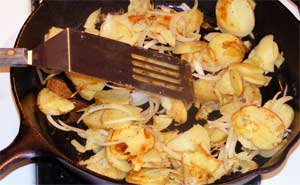 The phrase "rustle up some grub" carries more meaning when insects are on the menu. Not crawling around on it, mind you, but actually listed on the menu. Entomophagy, the practice of eating insects as food, is accepted – even celebrated - in most of the world's cultures.
The phrase "rustle up some grub" carries more meaning when insects are on the menu. Not crawling around on it, mind you, but actually listed on the menu. Entomophagy, the practice of eating insects as food, is accepted – even celebrated - in most of the world's cultures.
It's a custom that horrifies most Europeans and North Americans. But why? You really have to wonder at the selective squeamishness of people who consider snails to be a gourmet treat. Surely, it's just a short hop, or crawl, from snail to grasshopper, termite, or caterpillar.
The Ultimate Diet Food
Consider the benefits of incorporating insects into your diet.
• High protein, low fat. Hamburger is 18% protein and 18% fat. In contrast, moth larvae are 63% protein and 15% fat. Grasshoppers make high protein, low fat snacks that are relatively high in calcium and iron.
• Environmental benefits. Insects are low on the food chain, require minimal space and resources to raise, and have a better feed to meat ratio than more common farm animals like sheep, cows, chickens, and hogs. They don't require a lot of cropland or expensive petroleum-based fertilizers. You can grow them right in your apartment!
• Wilderness survival. Military manuals routinely include information about edible insects. In 1996, Scott O'Grady had to be thankful for that training. After being shot down in Bosnia, the Air Force captain evaded Serbian searchers for six days. He survived by using sponges to soak up water and eating grasshoppers. Ok. So maybe you'll never have your F-16 shot down behind enemy lines, but people get lost in the woods every day.
• Money saving. Why waste money on bait, tackle, and other expensive fishing equipment when you could just eat the bait instead? Entomophagy is a great way to grow food in a very small space at low cost. And just think; you'll rarely be asked to contribute a dish to potluck meals.
Insects aren't always a cheap food source. Prepared foods almost always cost more than homemade. Just two Chicken Stuffed Waterbugs will set you back $8 at the Typhoon Restaurant in Santa Monica, California. But, in general, insects provide high-quality protein at relatively low cost.
A World Crawling With Options
 It's estimated that between 50% and 80% of the world's people intentionally eat insects in some form. Over 1200 edible insects have been identified.
It's estimated that between 50% and 80% of the world's people intentionally eat insects in some form. Over 1200 edible insects have been identified.
Here are a few of the more familiar choices:
• Termites are an important food source in some parts of Africa. They're commonly roasted or fried. Adult queen termites (who may reach three inches or more in length) are considered delicacies.
• Locusts. Subsistence farmers have a strategy for dealing with locust swarms: they eat them. Locusts eat their weight in food each day and one ton of locusts (a tiny swarm) can eat enough food for 2500 people in one day. Farmers in Western Africa deal with the resulting destruction by consuming the culprits. Locusts may be dried, barbequed on skewers, or stuffed with peanuts and fried.
• Grasshoppers and Cicadas. Along with crickets, these are some of the most widely consumed insects. They're often served covered in chocolate. They can also be served roasted or boiled (although many people think that boiling destroys the distinctive, crunchy texture).
• Tarantulas are popular in Latin America. They're served fire-roasted, fried, or covered in sauces. Savor the crunchy legs contrasted against the soft, chewy middle portion.
• Mealworms are probably the most common entry-level insect. They're easy to find, inexpensive, and quite versatile. They can be chopped to make spreads and sandwich fillings, dried and used in place of nuts and raisins in recipes, or ground into flour for baking.
While every culture has some food taboos, very few eschew insects entirely. Even observant Jews who follow kosher dietary laws are permitted to eat four species of grasshoppers – although relatively few actually do.
One culture's "yuck" is another culture's "yum!"
Insect Preparation Tips
Every cook knows that the secret to yummy food is to use quality ingredients and careful preparation techniques. Entomophagy enthusiasts have published several popular cookbooks that provide specific preparation instructions and recipes. Check out these for ideas: Man Eating Bugs; Eat-A-Bug Cookbook, and Creepy Crawly Cuisine.
In the meantime, here are a few tips to help you get started:
• Never eat insects that were dead when you found them; chances are they've been poisoned.
• Be careful about collecting insects in the wild, particularly around cultivated fields. They may be contaminated with pesticides.
• Always remove the stingers and boil wasps before eating to neutralize the poison.
• Refrigerate live grasshoppers and crickets before cooking. The cooler temperature slows them down and makes them easier to handle.
• Be careful with the super size mealworms (those that are about three inches long with a hard skin). They're very mobile and do bite – although the bites aren't serious.
• Wait 24 hours before eating purchased insects. This gives them time to empty their digestive tracts.
One Little, Two Little, Insect Parts in Your Food
If you're thinking "there's no way I'd ever eat bugs," get ready for some bad news.
It's almost impossible to completely rid foods of insects and insect parts, so the US Food and Drug Administration sets standards for the amount of contamination that renders the food unsafe or unacceptable.
The crunch in your chocolate bar may not be from the nuts. Consider these guidelines:
• 100 grams of chocolate must have fewer than 60 insect fragments.
• Macaroni and noodle products should contain fewer than 225 insect fragments in 225 grams of product.
• Canned peas are rejected if they contain an average of 5 or more cowpea curculio larvae or the equivalent per No. 2 can.
• Golden raisins must have fewer than 10 or more whole or equivalent insects and 35 Drosophila eggs per 8 oz.
• Apples too insect-ridden to be sold for fresh eating are used to make apple cider.
 The average adult consumer has already inadvertently consumed a pound or more of insects and insect parts. Like most of the world's population, you've eaten insects and enjoyed them – even if you didn't realize it.
The average adult consumer has already inadvertently consumed a pound or more of insects and insect parts. Like most of the world's population, you've eaten insects and enjoyed them – even if you didn't realize it.
Sometimes it's just a matter of perspective. Would honey be as popular if the label read "Bee Vomit" instead? Maybe the solution is to find more familiar names for insect dishes. Names that make them sound like comfort food instead of something out of a Star Trek movie.
Three Bee Salad, anyone?





as you probably know, beekeepers whom are soley raising bees to sell the byproducts? of the bees (wax, honey etc etc) they will kill the bees in the fall..
However, he had said that the vacume cleaner he uses to kill them with, turns them into a mushy substance..
My basic question..
Could someone still dehydrate this substance, or simply add to a protien shake, and bottoms up? What becomes of the stingers? Would they be dangerious to me?
Thanks.
ps
I am interested in adding more protien to my diet, stereotypically when someone want’s to add muscle, they eat loads of red meat,? however that is NOT good for you, and I see entomophagy as a healthy choice.
In general, since the invention of the Langstroth movable frame hive in the mid 1800’s, killing bees at the end of the season is no longer a common practice. Beekeepers can get into a hive, extract honey, wax, propolis, and even royal jelly, all without killing the whole hive.
I am a beekeeper, and I know that building a hive up from scratch in the spring costs a lot of bee resources to build out a new hive. For example, bees will consume about 11 lbs of honey to produce 1 lb of wax. Thus, beekeepers generally consider fully drawn frames of beeswax and strong colonies as a valuable resource for maximizing yields from their beeyards.
As far as eating bees goes, I saw an article on TV once about making fried bee larva as a food, so I don’t think that bees are toxic. I would imagine that grinding the bees to a paste would also eliminate any problems with the stingers being long enough to still sting. Bees stingers have a little pump attached, so that when a live bee stings you, the pump is actually pulled out of her body and the pump continues to inject the venom into your skin.
The pump obviously would not be working in the bee paste, but the venom would still be “in the mix,” so if you showed any alergic reaction to bee stings, I would be very cautious about injesting them, in ANY form.